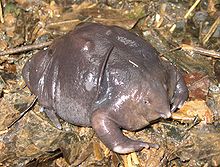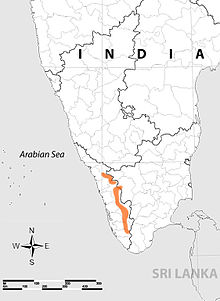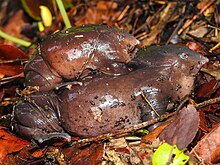Purple frog
| Purple frog | |
|---|---|

| |
| Nasikabatrachus sahyadrensis | |
| Calls of Nasikabatrachus sahyadrensis | |
| Scientific classification | |
| Domain: | Eukaryota |
| Kingdom: | Animalia |
| Phylum: | Chordata |
| Class: | Amphibia |
| Order: | Anura |
| Family: | Nasikabatrachidae |
| Genus: | Nasikabatrachus |
| Species: | N. sahyadrensis
|
| Binomial name | |
| Nasikabatrachus sahyadrensis Biju & Bossuyt, 2003
| |

| |
| Distribution range of Nasikabatrachus sahyadrensis (in ORANGE) | |
The purple frog (Nasikabatrachus sahyadrensis), Indian purple frog, or pignose frog is a frog species of the genus Nasikabatrachus. It is endemic to the Western Ghats in India. Although the adult frog was formally described in October 2003,[2] the juvenile form of the species was described earlier in 1917.[3]
History of the discovery
[edit]The species was described from specimens collected in the Idukki district of Kerala by S.D. Biju from the Tropical Botanic Garden and Research Institute in Palode, India, from the Vrije Universiteit Brussel (Free University of Brussels), in 2003. However, it was already well known to the local people and several earlier documented specimens and publications had been ignored by the authors in the 2003 paper that describes the genus and species.[4] Nasikabatrachus sahyadrensis closest living relatives are considered to be the Sooglossidae, only known in the Seychelles, an island chain in the Indian Ocean.[5]
Name
[edit]The scientific name Nasikabatrachus sahyadrensis is a Latinized portmanteau of the Sanskrit nāsikā (नासिका) for "nose", Greek batrachos (βάτραχος) for "frog", and Sahyadri, the native name for the Western Ghats which forms the purple frog's natural habitat.
One of its common names, the purple pig-nosed frog, also makes reference to the elongated morphology of its snout, which is well adapted to the acquisition of fossorial termites.
Description
[edit]The body of Nasikabatrachus sahyadrensis appears robust and bloated and is relatively rounded compared to other more dorsoventrally flattened frogs. Their flattened body assists them to cling to submerged rocks and boulders which essentially helps them fight strong currents, allowing them to remain near stream banks where they typically reside.[6] Its arms and legs splay out in the standard anuran body form. Compared to other frogs, N. sahyadrensis has a small head and an unusual pointed snout. Adults are typically dark purplish-grey in color. Males are about a third of the length of females.[7] The specimen with which the species was originally described was 7.0 cm (2.8 inches) long from the tip of the snout to the vent. Tadpoles of the species had been described in 1917 by Nelson Annandale and C. R. Narayan Rao as having oral suckers that allowed them to live in torrential streams.[3][8] Suckers are also present in rheophilic fishes of genera such as Glyptothorax, Travancoria, Homaloptera, and Bhavania, adaptations that are the result of convergent evolution. Some of these fishes co-occur with Nasikabatrachus tadpoles in the hill streams.[7][9] Its vocalization is a drawn-out harsh call that sounds similar to a chicken clucking. Males of this species exhibit the unique behavior of calling from under a thin layer of soil. Some other burrowing frogs (Myobatrachus gouldii and Arenophyrne rotunda) are known to do this, but these frogs have also been observed to call from the surface, while N. sahyadrensis has not.[10] The frogs may switch to headfirst burrowing due to their wedge-shaped skull and other shaped limbs.[11]

Distribution
[edit]Earlier thought to be restricted to the south of the Palghat Gap in the Western Ghats, additional records have extended its known range farther north of the gap.[12][13] The species is now known to be quite widely distributed in the Western Ghats, ranging from the Camel's Hump Hill Range in the north, all the way to the northernmost portions of the Agasthyamalai Hill Range in the south.[7]
Ecology
[edit]Like many frogs, the Indian purple frog is well-adapted to its subterranean environment.[14] The frog spends most of its life underground and surfaces only during the monsoon, for a period of two weeks, for mating.[15] With few field scientists out in the field during the rainy season, the species was discovered and studied only in recent times. Males emerge to call beside temporary rainwater streams. They mount females and grip them (amplexus) along the vertebral column. The females then carry the male frogs on their backs to the egg laying sites which are usually crevices along the fast-flowing streams.[16] Around 3000 eggs are laid in a rock pool and the tadpoles metamorphose after around 100 days.[7]


Unlike many other burrowing species of frogs that emerge and feed above the ground, this species has been found to forage underground, feeding mainly on termites using its tongue and a special buccal groove.[17]
In 2015, tadpoles of the species were discovered to be traditionally consumed by tribal communities.[18]
The major threat to these amphibians in the Western Ghats of India is caused by the alteration of natural habitats by an ever-increasing human population, resulting in large areas being converted for settlement and agricultural use. Recent studies have shown frog utilization to be one of the major threats, which include the utilization of frogs for food, traditional medicine such as a cure for burns, asthma, and other lung ailments,[18] research purposes, and pet trade has also been considered a major contributor to their decline. Tadpole-harvesting was prevalent in the monsoon season during July–September every year. The Nadukani-Moolamattom-Kulamaav tribal people have developed an indigenous method for collecting these uniquely adapted suctorial tadpoles. Usually, about 2–5 individuals would participate in each harvesting event.[18] The Purple Frog growth also depends on the velocity of the water. When the velocity of water increased, there was a greater number of tadpoles than the lower velocity of water areas in both streams. The tadpoles also had constant activity in the streams as well. They also have a huge influence on the number of tadpoles in the environments they are in.[18] Due to increasing population in India where the purple frogs are native to, large open areas where purple frogs typically reside are being reconstructed for agricultural and settlement purposes. This has led to almost 40% of all amphibians in the Western Ghats of India going extinct, due to a lack of data the remaining amphibians are mostly unresearched with no knowledge of ecology, biology, defining characteristics, threats faced (Thomas & Biju, 2015).
The building of dams during monsoon season is affecting the loss of microhabitat that is needed for survival of the Purple Frog. The harvesting of tadpoles by indigenous communities is also a factor for their endangerment.[19]
References
[edit]- ^ IUCN SSC Amphibian Specialist Group (2022). "Nasikabatrachus sahyadrensis". The IUCN Red List of Threatened Species. 2022: e.T58051A166098621.
- ^ Biju, S. D.; Bossuyt, F. (2003). "New frog family from India reveals an ancient biogeographical link with the Seychelles". Nature. 425 (6959): 711–714. Bibcode:2003Natur.425..711B. doi:10.1038/nature02019. PMID 14562102. S2CID 4425593.
- ^ a b Annandale, N. & Rao, C.R.N. (1917). "Indian tadpoles". Proceedings of the Asiatic Society of Bengal. 13: 185–186.
- ^ Das, Indraneil (2007). "Some forgotten descriptions of Nasikabatrachus (Anura - Sooglossidae)". Herpetological Review. 38: 291–292.
- ^ Biju SD, Bossuyt F. New frog family from India reveals an ancient biogeographical link with the Seychelles. Nature. 2003 Oct 16;425(6959):711-4. doi: 10.1038/nature02019. PMID 14562102.
- ^ Senevirathne G, Thomas A, Kerney R, Hanken J, Biju SD, Meegaskumbura M. From clinging to digging: The postembryonic skeletal ontogeny of the indian purple frog, Nasikabatrachus sahyadrensis (anura: Nasikabatrachidae). PLOS ONE. 2016;11(3):e0151114.
- ^ a b c d Zachariah, A; RK Abraham; S Das; KC Jayan & R Altig (2012). "A detailed account of the reproductive strategy and developmental stages of Nasikabatrachus sahyadrensis (Nasikabatrachidae), the only extant member of an archaic frog lineage" (PDF). Zootaxa. 3510: 53–64. doi:10.11646/zootaxa.3510.1.3.
- ^ Annandale, N. (1918). "Some undescribed tadpoles from the hills of southern India". Records of the Indian Museum. 15: 17–23.
- ^ Annandale, N. & Hora, S.L. (1922). "Parallel evolution in the fish and tadpoles of mountains torrents". Records of the Indian Museum. 24: 505–510.
- ^ Thomas, Ashish; Suyesh, Robin; Biju, S. D.; Bee, Mark A. (7 February 2014). "Vocal Behavior of the Elusive Purple Frog of India (Nasikabatrachus sahyadrensis), a Fossorial Species Endemic to the Western Ghats". PLOS ONE. 9 (2): e84809. Bibcode:2014PLoSO...984809T. doi:10.1371/journal.pone.0084809. ISSN 1932-6203. PMC 3917828. PMID 24516517.
- ^ PLOS ONE, 2016, Volume 11, Issue 3
- ^ Das, K. S. 2006 Record of Nasikabatrachus from the Northern Western Ghats. Zoos' Print Journal 21(9):2410
- ^ Radhakrishnan, C.; K.C. Gopi & K.P. Dinesh (2007). "Zoogeography of Nasikabatrachus sahyadrensis Biju and Bossuyt (Amphibia: Anura; Nasikabatrachidae) in the Western Ghats, India". Records of the Zoological Survey of India. 107 (4): 115–121. doi:10.26515/rzsi/v107/i4/2007/159116. S2CID 251728922.
- ^ Bittel, J. (2021, May 4). New purple pig-nose frog found in Remote Mountains. Animals. [1].
- ^ Marshall, Presented by Michael (17 October 2014). "Eight ugly animals we should save anyway". BBC Earth. Retrieved 3 January 2015.
India's purple frog spends almost all the year underground, surfacing for around two weeks in the monsoon to breed in temporary ponds created by the torrential rain.
- ^ Das, Sandeep; Tapley, Benjamin; Gray, Claudia; Das, Jyoti; Divakar, Nithin (2019). "A Survival Blueprint for the conservation and management of the Purple Frog Nasikabatrachus sahyadrensis, in Kerala, India" (PDF). The EDGE of Existence Fellowship. Zoological Society of London.
- ^ Radhakrishnan, C.; Gopi, K. C.; Jafer Palot, Muhamed (2007). "Extension of range of distribution of Nasikabatrachus sahyadrensis Biju & Bossuyt (Amphibia: Anura: Nasikabatrachidae) along Western Ghats, with some insights into its bionomics" (PDF). Current Science. 92 (2): 213–216.
- ^ a b c d Thomas, A.; Biju, S. D. (2015). "Tadpole consumption is a direct threat to the endangered purple frog, Nasikabatrachus sahyadrensis". Salamandra. 51: 252–258. Archived from the original on 25 September 2015.
- ^ Thomas, Ashish; Das, Sandeep; Manish, Kumar (1 June 2019). "Influence of stream habitat variables on distribution and abundance of tadpoles of the endangered Purple frog, Nasikabatrachus sahyadrensis (Anura: Nasikabatrachidae)". Journal of Asia-Pacific Biodiversity. 12 (2): 144–151. doi:10.1016/j.japb.2019.01.009. ISSN 2287-884X.
External links
[edit] Media related to Nasikabatrachus sahyadrensis at Wikimedia Commons
Media related to Nasikabatrachus sahyadrensis at Wikimedia Commons- Edge of Existence page on Nasikabatrachus sahyadrensis
- Continental drift and the Sooglossidae Archived 24 May 2011 at the Wayback Machine
- AmphibiaWeb page on Nasikabatrachus sahyadrensis
THOMAS, A., & BIJU, S. D. (2015). Tadpole consumption is a direct threat to the endangered purple frog, Nasikabatrachus sahyadrensis. Salamandra, 51(3), 252–258.

